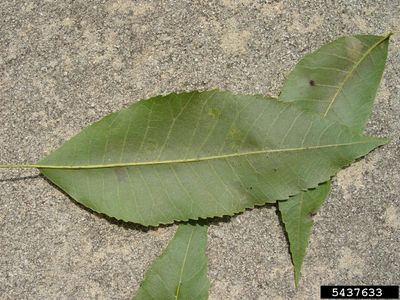Symptoms of a Pecan Tree with Bacterial Leaf Scorch
Pecan bacterial leaf scorch afflicts over 30 cultivars as well as many native trees. Scorch on pecan leaves manifests as premature defoliation and a reduction in tree growth and kernel weight. Young leaves turn tan from the tip and edges towards the middle of the leaf, eventually browning entirely. Soon after symptoms appear, the young leaves drop. The disease may be seen on a single branch or afflict the entire tree. Bacterial leaf scorch of pecans may start as early as spring and tends to become more destructive as the summer progresses. For the home grower, a tree afflicted with PBLS is just unsightly, but for commercial growers, the economic losses can be significant. PBLS is caused by strains of the bacterium Xylella fastidiosa subsp. multiplex. It may sometimes be confused with pecan scorch mites, other diseases, nutritional issues, and drought. Pecan scorch mites can be easily viewed with a hand lens, but other issues may need to have testing done to confirm or negate their presence.
Treatment of Pecan Bacterial Leaf Scorch
Once a tree has been infected with bacterial leaf scorch, there are no economically effective treatments available. The disease does tend to occur more frequently in certain cultivars than others, however, although currently there are no resistant cultivars. Barton, Cape Fear, Cheyenne, Pawnee, Rome, and Oconee are all highly susceptible to the disease. Bacterial leaf scorch of pecans can be transmitted in two ways: either by graft transmission or by certain xylem feeding insects (leafhoppers and spittlebugs). Because there is no effective treatment method at this time, the best option is to reduce the incidence of pecan leaf scorch and to delay its introduction. That means purchasing trees that are certified disease-free. If a tree appears to be infected with leaf scorch, destroy it immediately. Trees that are going to be used for rootstock should be inspected for any signs of the disease prior to grafting. Lastly, only use scions from non-infected trees. Visually inspect the tree throughout the growing season prior to collecting the scion. If trees for grafting or collection of scions appear to be infected, destroy the trees.
